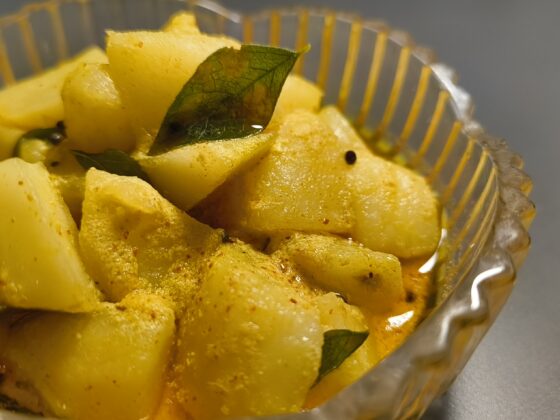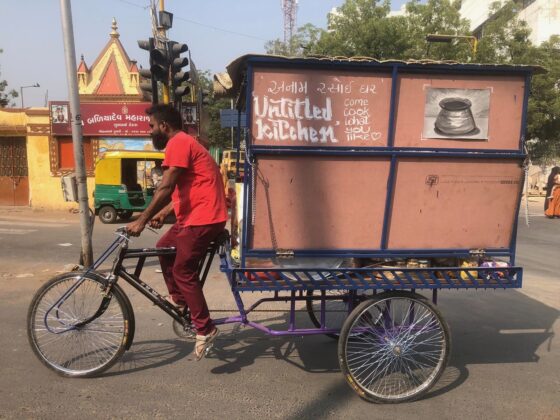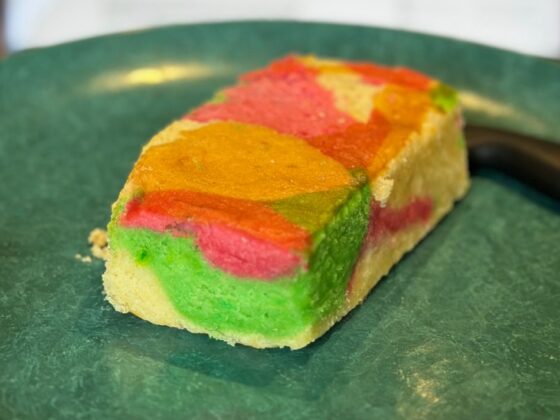A morning spent at Bengaluru’s Russell Market reminds us of the forgotten art of engaging with familiar strangers, and taking pleasure in hand-picking fruits and vegetables for our everyday needs. Meet its people, and the produce they bring to the table.
Even though it’s bright and sunny outside, the inner corridors of Russell Market are cool and dim. We’ve left the chaos of morning outside, where sacks of cauliflowers are being loudly unloaded and cleaned on the footpath.
Inside stands a diminutive, bespectacled man, slowly puffing on a cigarette in the middle of the almost bare first aisle. On the table in front of him are packets of marigold, zinnia, dahlia, petunia, coreopsis, and chrysanthemum seeds, once procured “from Kashmir, but now from dealers in Pune and Mumbai”. Behind him hang plastic sachets of Shoot rat poison.
As verses from the Hadith on how to keep the evil eye at bay play on his phone in the background, he speaks to us in his barely-audible genteel voice. He reminisces about participating in Gandhi’s Satyagraha movement in British Ooty, before his family relocated to Bangalore in the 1950s to start a vegetable business. At that time, they paid a deposit of Rs 60 for the stall.
Wearing a navy blue V-neck sweater, reminiscent of convent school uniforms, he embodies a gracious dignity. For the last seven decades, G Mohammed has been a part of Russell Market. He cheekily shares his age, “April mein 88 khatam hua. Abhi 89 running.” (I turned 88 in April, and now I look forward to my 89th birthday.)
A decade ago, he had to get a licence for Rs 3,000 so that he could continue selling at the market. His monthly electricity bill of Rs 400 is over twice the rent he pays for his stall—at number 36.
He takes a ‘share’ auto for Rs 30 to the market every morning from his home in Bamboo Bazaar. After a breakfast of chapati and sabji at an eatery nearby, he sets up his stall at seven thirty. His son relieves him at noon, after which he goes home to rest. Sales are not consistent, he told us, and his daily revenue ranges from Rs 500 to Rs 3,000, with weekends being the most profitable.
As we continue to speak with this gentleman, he reminds us of an art that many of us have forgotten. The art of being a customer and interacting with human beings for our daily needs. The art of holding conversations with familiar strangers. An art that is slowly dying with the takeover of grocery shopping apps. An art that is disappearing as the metropolis expands.
(Also read our introductory piece to this market archive series, Russell Market: Almost a Century-Down, But Not Out!, and one that traces the structure’s history and explores its design, Built in 1820, an Old Clock Tower Forms the Nucleus of the Market.)
So many others whom we speak to are skilled at this art, ready to draw us into conversation, if necessary. The interactions at Russell Market are not purely transactional. Grocery shopping becomes an immersive, sensorial experience. This is especially true of the fresh seafood section, perhaps the most bustling part of the market out back, which opens for business at six every morning.
The variety is baffling for anyone but the most seasoned consumer of seafood, with produce coming in from the coasts of Tamil Nadu, Maharashtra, and Goa, besides Mangalore. King fish, tiger prawns, barracuda, mud and sea crabs, India dog shark, Guitar fish, pomfrets, leatherskin, and sheela are merely some varieties we spot. The sellers don’t let any lack of consumer awareness get in the way; they are more than willing to share their rather extensive knowledge.

Srinivasan of MLS Seafood, of shop number 15, calls out to us, asking if we’re looking for something specific. It turns out that we’re a little late to get the choicest fish, even if we were. He tells us how most of the best stock is sold out before eight in the morning, and all that’s left are the pickings. Of the lot, however, king fish seems to sell the most.
The owner of another of these stalls, Mukram Sharieff, and his decade-long friend, Waheed, make us feel seen, and as though they’ve been waiting for a chat with us.

They trace the stall’s journey back to 1937 when Mukram’s grandfather was one of the first few recipients of a government allotment. Over the decades, the number of allotments increased. As more shops and stalls sprouted, there was less space, forcing Mukram, among other stall holders, to display his wares out on the street.
Mukram and Waheed talk of how things have changed: they cover everything from the dissolving demand for fresh seafood to the quality and the ever rising price of fish. Mukram shares that his stall once boasted the biggest catch in the market, “a single fish weighing up to 800 kg, and as long as the shop is tall”.
He recalls the competitions held in the 1970s, and how their stall won the award of the biggest catch several years in a row. “Nowadays, people have lost interest in these things,” he rues.
Noori offers a quiet contrast to these two (endearingly) talkative friends. She is one of those women who are a guaranteed entity in every fish market: the ones who gut and clean your haul, if you’d rather not take it home and go through the trouble of doing it yourself. There’s a rhythm to Noori’s movements that’s almost hypnotic to watch: slit, gut, clean, slit, gut, clean.

There’s a rhythm to Noori’s movements that’s almost hypnotic to watch: slit, gut, clean, slit, gut, clean.
It’s easy to miss her, unless you’re a regular at Russell Market for fish. Only the rising pile of cleaned fish by her indicates how intrinsic she is to the ongoing—and mostly loud—transactions around her, and not a mere spectator. She agrees to let us take her picture, but after this short interaction, we decide to leave her undisturbed in an almost private pocket, her very own for as long as she’s working.
Like Noori, there are others, cleaners and chaiwallas not least of them, who are important pieces to the jigsaw of the market who have no formal stall. Yet, they bring structure—often refreshment—to vendors and customers alike.
Back inside the market, Akbar, too, offers food to fellow vendors. He has moved his Cochin Seafood back to the walled environs and switched out his fresh fish for frozen and salt-cured produce. Having found his nook between the closed doors of dairy and ghee shops, he’s detached from and yet in proximity to the bustling fresh seafood market outside the walls.

While allowing that fresh seafood continues to sell better than his wares, he’s submitting, in part, to the convenience foods trend—frozen fish preserves longer.
However, many vendors, including Akbar himself, are regular consumers of some of his wares. Fried salt-cured fish has become a staple of sorts. “We fry it and eat it with lunch,” he says.
Perpendicular to the rather social fish market is a busier section of the meat market: poultry and mutton stalls cheek by jowl. Owners and workers there recommend each other’s stalls, and many seem to go back years, decades, or even generations, like Musheer Ahmed, a butcher who’s the third in his family to run the business.

Across the road from Musheer and the other butchers is an opening to the sheltered market—its fruit and vegetable section.
It stands out as the best-lit, most spacious, and cleanest section, calling out to those who enjoy imported and exotic varieties. Extravagant fruit baskets are sold as gifting options. We catch sight of naati—read ‘native’—tomatoes and onions, bok choy and brussels sprouts, and everything in between. One of our writers has even found the softest tofu in this section.
It stands out as the best-lit, most spacious, and cleanest section, calling out to those who enjoy imported and exotic varieties. Extravagant fruit baskets are sold as gifting options. We catch sight of naati—read ‘native’—tomatoes and onions, bok choy and brussels sprouts, and everything in between.
Farooq, younger than most other vendors in the inner market, has recently been assigned here. He mans a large stall—two allotments combined—for a company that has hired him. He’s already been written about; he is proud to show us the article in Malayalam Manorama. Ask him what it’s about, he says he can’t read. But that does not deter him. He pulls out his smartphone to scan the article, and runs it through Google Translate.
We want to know which fruit is his favourite, but he says, “I don’t eat these, they’re too expensive for me.”

Further down the aisle, Vadivelu’s stall—selling seasonal local wares such as amla, green papaya, turmeric mango ginger, and tiny mangoes—is small and rather nondescript. The economic struggles that came with the covid-19 pandemic have worn him down. “The market closed down, and I had to appeal to my personal contacts to help me get a pass to sell groceries door-to-door,” he recalls. He had almost no income during this period.

The going continues to be tough post-pandemic, too. Although restrictions have been lifted “most customers are now accustomed to buying online”. Meanwhile, expenses burn a hole in his pocket—he pays Rs 160 a month as rent and Rs 250 for electricity. “I don’t want my son to get into this business, it will end with me.”
Jesse has noticed a disheartening drop in sales in the vegetable section, too, so she uses her stall for storage. She has moved out front to set up an eye-catching stall selling limes, choosing to work during the pandemic.
The 62-year-old is surrounded by those who chose to work, underscoring a sense of belonging exuded by the market. Her brother is an autorickshaw driver in the neighbourhood, a reassuring presence. Her son, a coolie in the market, helps her move her sacks of produce bought once a week from KR Market.
Business begins at seven in the morning for her and goes on till four in the evening, when her son takes over from her, until seven in the evening. She is dependent on her children to run the stall and take care of logistics such as rent and electricity bills.

Jesse is embarrassed that she was never formally educated. Yet, she’s quick to total for customers, varying prices for varying sizes of limes not stumping in the least: three for Rs 20, four for Rs 20, five for Rs 20, or one for Rs 8. As sunny as her wares and a fount of conversation—in Tamil, Hindi, Telugu or Kannada, take your pick—Jesse concludes our interaction with a lesson in measurement: 1 mutta ≈ 34 kg, one-tenth her weekly purchase.
Vying in vibrance with Jesse’s stall, are several others on the inside that deal in flowers. We stop at one displaying a framed photograph of actor Dilip Kumar, among other pictures, wearing a garland. Here we find Mohammad Ilyas, arranging flowers.

Like his neighbouring flower sellers, he has woven many garlands, even humongous ones often bought by politicians. We ask him if the flowers he sells have changed over the years. His observation: “They are not as fragrant anymore, because of the heavy use of chemicals (when they are grown).”
We make a last stop by another stall for flowers, this time by the entrance, where Kasturiamma, a municipality worker, is taking a breather in her workday, which begins at 6 am.
“I’m friendly with everyone, but these people are my friends,” she says, nodding towards the flower sellers right opposite her. Theirs is a friendship grown over the three decades she has worked there, evidently full of comfortable silences amid jesting.
When we catch her, it is just after the chai seller has been by, and she has a few minutes to spare to chat, and even ask after us: if we’ve had a chance to eat yet that day.

She walks us through her daily routine: at six in the morning, she arrives at the market in a share auto. She usually buys lemon rice, or chitranna, from a shop close by for breakfast, and leaves the market at two in the afternoon. She finds solace amongst her group of ‘cleaning ladies’ which include her friends Shanti, Renuka, Padma, Adi Amma, Chandramma, Lakshmi Amma, Lakshmi Devi and Ammu.

For all of Rs 450 a month, she has the sole responsibility of keeping the inside of the market clean—sweeping and clearing away any waste—just as her fellow worker does around the perimeter. Yet her true currency is forging connections with the vendors who inhabit the market, those who pass by in a flash, in a few months or a year, and those who have spent decades building their life on it.
We may not have eaten yet, but as we talk to Kasturiamma, and the others who people the market, we feel oddly satiated. Good conversation, the very rarest of wares, can be as fulfilling as a hearty meal.
Pankhuri Agrawal is an independent writer and researcher based in Bangalore. The covid lockdowns spurred her to write short essays on spices and nostalgia. She recently completed a research project on street vendors for Prof. Krishnendu Ray, NYU. She runs the Yayavr Food Book Club which discusses the history, sociology and literature of food in India. In what seems like another life, she studied architecture and philosophy, and performed classical Manipuri dance across the U.S. and India. Her two children love to bake banana bread and slurp nalli soup with her.
Amiya Chaudhuri is a research associate at Belongg and a sociology graduate from Shiv Nadar University. She is interested in the intersection of food, identity, and social justice, and hosts a Belongg podcast on inclusive food systems. She has previously served as an AIF Clinton Fellow, worked with Timbaktu Collective in Andhra Pradesh, and conducted ethnographic research projects on food and caste identity in the city.
Sreepathy Palliath is a digital marketer living in Bangalore who spends most of his days making ramen, striking up imaginary conversations with the cows of Bangalore, and eating his way through pretty much anything Asian. He’s also working towards his dream of being a chef one day and is currently getting trained at Alt. Pizza.
Shreshtha Chhabra is a researcher and writer with an inclination towards the food-art-community nexus, studying food from the intricate perspectives of policy, societal impact and collective sustenace. With an inclination in art and design, she is also exploring different forms of creative expression.
Chetana Divya is an introvert who enjoys being a fly on the wall in buses and markets, and seeks out everyday stories that play out in truly democratised everyday spaces.
Sanskriti Bist is a freelance food stylist, photographer and recipe developer living in Bangalore. She loves to cook everything from scratch and take photos of markets, food and her kitchen.
Vanmayi Shetty is a multidisciplinary visual artist and art director with a lens-based background in social documentary and storytelling. The narratives in her work stem from a people and planet perspective and flow through a wide range of media. See her work here.
With the intention of seeing a market through different eyes and perspectives, a group of us met at the end of 2022 to walk through Bengaluru’s Russell Market to document it. Other writers who have worked on this project are Dhiraj Chilakapaty, Ruth Dsouza Prabhu, and Shivani Unakar; also involved were Chef Thomas Zacharias, Takshama Pandit, Yamini Vijayan, and Zainab Kapadia from The Locavore.

Markets carry the pulse of the communities that they serve, and act as a window to diverse cultures. Market Archives aims to document as many markets from around India as possible—small, sprawling, vanishing, noisy, up a hill, tucked away in a corner of the city—every one of them. Join us as we speak to different sellers, see what’s in season across varied geographies, taste the familiar and unfamiliar, and soak in the sounds and scents that define each market.




